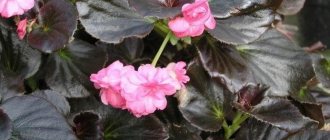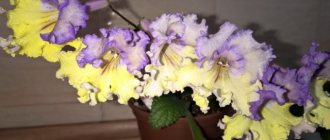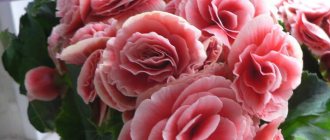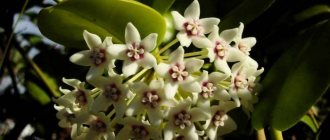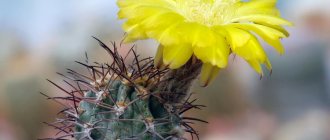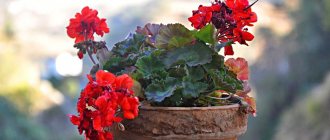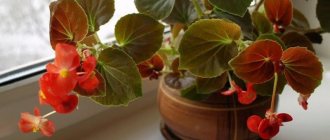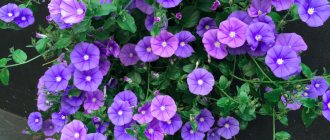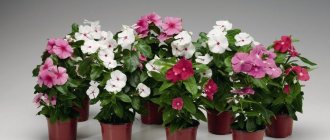Ampelous begonia is the most decorative and beautiful variety of begonias. The flowing shape of the bush, long flowering and variety of flower colors make this plant one of the most popular in vertical gardening. In flowerpots and hanging flowerpots, ampelous begonia will become an exquisite decoration for your home, balcony or terrace, and planting and caring for plants will not cause you much trouble. Watering and fertilizing is all that begonia needs for lush flowering from spring to late autumn.
general characteristics
The peculiarity of ampelous begonia is its graceful hanging shoots, reaching a length of 30–45 cm, and forming a picturesque cascade of bright flowers. The buds are formed in the leaf axils at the level of 5–6 nodes and have elongated pedicels. Begonia flowers are of two types: male - double, large (up to 8 cm in diameter), and female - simple and smaller (about 5 cm).
Begonia blooms continuously and for a long time, starting in mid-May and, if it is provided with proper care, lasts until the beginning of autumn. Ampelous varieties are ordinary and tuberous. Tuberous begonia is dug up for the winter, and with the arrival of spring, the tubers are sprouted and planted again. Regular, non-tuberous varieties are easier to grow using cuttings.
Landing in the ground
Begonias are planted in the ground at the end of May, when the weather is more or less stable and frosts are not predicted. If you are in the northern region, you can wait until the beginning of June. It is advisable to check the weather for a week in advance in order to have time to take care of the plant. If it rains, you can cover the seedlings with polyethylene or lutrasil.
You need to plant it immediately in a prepared hole, which is filled with a special soil composition. For the first three weeks, it is necessary to constantly feed the plant.
There is no need to worry that the begonia will stop growing. Even in extreme heat this can be avoided. It is enough to increase the volume of liquid for irrigation.
Popular varieties
The number of modern hybrids of ampelous begonia is so large and diverse that they form entire series. Almost all varieties are resistant to weather conditions and are not damaged by rain drops, as happens with other types. The Pendula and Chanson series are considered the most beautiful and in demand in gardening.
Begonia Pendula is a tuberous variety suitable for growing in pots. It is compact and quickly forms buds that bloom before the leaves appear. The flowers are large, often double, mostly red and pink.
White begonia Chanson
Yellow begonia Chanson
Red Begonia Pendula
Orange Begonia Pendula
Begonia Chanson - this series consists of a dozen varieties of various shades: white, yellow, salmon, vanilla, red. There are also a couple of hybrids with two-tone variegated colors. All varieties from this series have double or semi-double flowers with a diameter of 6–8 cm. Chanson is considered the most decorative ampelous variety.
Landing Features
Ampelous begonia is grown in hanging pots or pots on a stand, allowing the stems to grow vertically. The time and method of planting depend on the variety. Some varieties do not need winter rest and bloom all year round. Their cuttings can be planted as early as early January, so that the buds will bloom by spring, and put indoors for the winter. If the begonia is tuberous, then it is planted in the spring, when the tubers begin to wake up.
Planting material is disinfected in a 1% solution of potassium permanganate or peroxide, then the tubers are cut so that each part has at least two buds and planted in pots with the buds facing up. A drainage layer is required. It is important to know that begonias need slightly acidic soil. The ideal option for it is a soil mixture consisting of equal parts of foliage, turf soil, sand and a small amount of vermiculite.
Seedling care
The first shoots will appear 2 - 3 weeks after sowing. Old seeds may take longer to germinate, up to a month. The seedlings are very small and often not visible to the naked eye.
Development is very slow; it can take more than a month before the first true leaves appear. At this time, begonia is very vulnerable; it is necessary to carefully monitor the soil temperature and humidity.
Begonia develops best at temperatures from 15 to 22 °C. If the soil is colder, fungal diseases such as blackleg may appear. It is not difficult to notice the first signs of the disease; plants stop growing and quickly wither. In this case, it is urgent to treat with fungicides and replant the plants in clean soil. At higher temperatures, begonia may stretch. In addition, the soil dries out faster, making it more difficult to maintain the necessary moisture.
Water the shoots of hanging begonia from a spray bottle or pointwise from a syringe with a needle at the root. The spray bottle is set to the finest spray; large drops can break the stem. The film with which the greenhouse was covered is not removed until real leaves appear on the seedlings. Sometimes mold may appear on the surface of the soil, in which case the seedlings are sprayed with a pink solution of potassium permanganate. Most often, it does not interfere with the development of plants; after the cover is removed, the mold disappears completely.
After the true leaves appear, the begonia begins to harden off. Plants are left without shelter for half an hour, increasing the ventilation time by an hour every day. After 2 weeks, you can leave the flowers open overnight.
If necessary, the ampelous begonia is picked. The soil used is the same as for germination. You can plant plants in separate containers, for example, cassettes, or in a common one. The volume of individual containers is from 0.2 to 0.5 ml. The total size depends on the number of plants planted, the distance between them should be at least 3 cm, the height of the soil layer should be at least 5 cm. Plants sown in tablets do not need picking.
Grown plants are planted in pots or flowerpots on a leg. If the plants will be indoors, the timing of transplantation does not matter. Begonia is planted in flowerpots that are located outside after the soil has warmed up to 15 °C, having previously prepared a shelter in case of frost.
Rules of maintenance and care
Ampelous begonia prefers sunny places, but the plants need to be placed so that the sunlight is diffused. A comfortable temperature for it is 20–22 °C, so in summer it is better to place the pots in partial shade. How to care for ampelous begonia? There is nothing special or complicated about this.
Care at home and in the garden consists of regular watering and fertilizing. To prevent the tuber from rotting, it is better to pour water along the edge of the pot. When watering, do not allow the soil to become waterlogged or dry out.
For lush flowering, plants need to be fed.
In the spring, nitrogen fertilizers are applied, and during the entire flowering period, potassium-phosphorus mixtures are applied at intervals of 2 times a month. It is advisable to alternate mineral fertilizers with organic ones. Flower care also includes timely removal of faded buds.
How to care for ampelous begonia
At the end of May, the plants usually have time to form well and are ready to be transplanted to a permanent location. Rather, they are not replanted, but rather transferred, because the shoots, which by this time have already stretched out, are quite fragile.
For hanging begonias, hanging pots are usually chosen, placing up to three plants in them. Drainage is also laid at the bottom; it is possible to use pebbles, expanded clay or broken bricks.
Begonia blooms long and luxuriously with proper care, but there is no need to hang it in a very sunny place, it will stop blooming and may die. Light partial shade and diffused light on the terrace are the most suitable options for her.
Watering and fertilizer rates remain the same as for seedlings. Watering should be frequent, but in moderation, so that the soil has time to dry out a little. Do not use chlorinated tap water or water that is too cold.
Non-tuberous begonia can bloom at home for a very long time. Tuberous hanging begonia needs rest. After flowering, all shoots are removed and the plant is placed in a cool room. Then watering needs to be sharply reduced and fertilizing should be removed altogether.
Reproduction of ampelous begonia
In addition to seeds, begonias can easily be propagated by dividing the tuber; there should be several buds on it. Based on their number, the number of divisions is made. Growing begonia from tuber pieces is much faster than from seeds.
The plant can also be propagated by layering and shoots. This is usually done in the spring, several of the largest shoots are cut off and rooted in a moist substrate, then transplanted into separate pots. When propagated by cuttings, all characteristics of the variety are preserved.
Reproduction techniques
Begonia can be propagated from cuttings, seeds and tubers. The seed method is very labor-intensive and troublesome. The seeds are small and take a long time to germinate; besides, ampelous begonia, when grown from seeds, can bloom only the next year. But the flower is propagated by cuttings and tubers without any problems. A young shoot or leaf is used as a cutting. It needs to be placed in water, germinated, and then planted in a pot. How begonia reproduces by tubers was described above.
Sowing
When everything is ready for planting, you first need to pour drainage into the container. This is done so as not to over-moisten the soil. Because in such a case, decay may occur. For drainage, you can choose small pebbles, pebbles or glass beads. Now you can lay out the soil you made. Then use a spray bottle to lightly moisten it. The soil should be moist, not wet.
Now you can spread the seeds over the entire surface and lightly press them to the ground, but there is no need to immerse the seeds inside. There is no need to put anything on top. If you use a peat tablet, then you need to make sure that the soil does not dry out. Cover the top with glass or cling film and place on the windowsill, on the south side.
The temperature in the room should be from 20 to 27 degrees Celsius. It is necessary to wet the soil using a spray bottle or through a tray, since a direct stream can wash away the seeds. The first shoots can be seen after nine days.
Disease Prevention
Ampelous begonia is highly resistant to diseases and is rarely damaged by pests. However, improper care or unfavorable weather conditions can contribute to the occurrence of these problems. Thus, with excessive watering and during periods of prolonged rain, fungal diseases (powdery mildew, gray rot) or root infections can develop on plants. When it is not possible to control humidity, it is better to treat flowers with fungicides: 1% Bordeaux mixture or copper sulfate.
In the summer, pests begin to become active: aphids, spider mites, leaf nematodes and other harmful insects. In a matter of days, they can damage the delicate leaves, depriving the plant of its decorative properties. To prevent this from happening, begonias and flowers growing nearby need to be treated with Fitoverm 2-3 times per season. Do not neglect preventive treatments, because they help protect plants and prolong their magnificent flowering.

